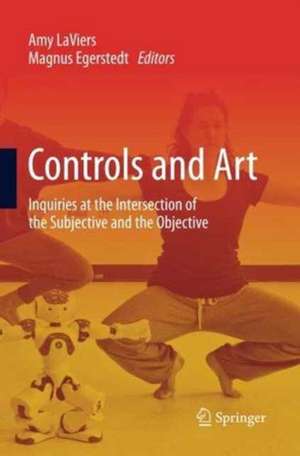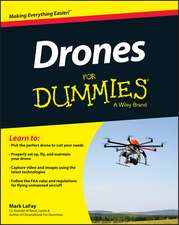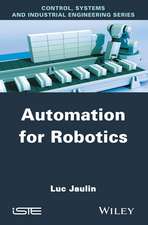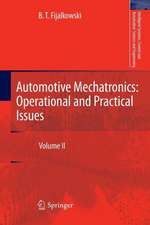Controls and Art: Inquiries at the Intersection of the Subjective and the Objective
Editat de Amy LaViers, Magnus Egerstedten Limba Engleză Paperback – 27 aug 2016
To ensure that artistic influences are well represented, the individual chapters are focused so that they relate their contribution to the arts meaningfully and explicitly. Specially composed introductions set up the contributions either in terms of inspiration by artistic principles or their contribution to the arts through new analysis tools. To facilitate this, the majority of the chapters are authored jointly by experts in control theory and by artists, including dancers, choreographers, puppeteers and painters. Connections between controls and art then permeate the text so that these important relationships play a central role in the book.
Controls and Art surveys current projects in this area—including a disco dancing robot, a reactive museum exhibit and otherworldly music—and illuminates open problems and topics for research in this emerging interdisciplinary field. It will draw attention both from experts in robotics and control interested in developing the artistic side of their creations and from academics studying dance, theater, music and the visual arts with an interest in avant-garde means of production.
| Toate formatele și edițiile | Preț | Express |
|---|---|---|
| Paperback (1) | 556.40 lei 38-44 zile | |
| Springer International Publishing – 27 aug 2016 | 556.40 lei 38-44 zile | |
| Hardback (1) | 647.40 lei 6-8 săpt. | |
| Springer International Publishing – 4 feb 2014 | 647.40 lei 6-8 săpt. |
Preț: 556.40 lei
Preț vechi: 695.50 lei
-20% Nou
Puncte Express: 835
Preț estimativ în valută:
106.49€ • 109.75$ • 89.91£
106.49€ • 109.75$ • 89.91£
Carte tipărită la comandă
Livrare economică 27 februarie-05 martie
Preluare comenzi: 021 569.72.76
Specificații
ISBN-13: 9783319352176
ISBN-10: 3319352172
Pagini: 243
Ilustrații: VIII, 235 p. 107 illus., 71 illus. in color.
Dimensiuni: 155 x 235 mm
Ediția:Softcover reprint of the original 1st ed. 2014
Editura: Springer International Publishing
Colecția Springer
Locul publicării:Cham, Switzerland
ISBN-10: 3319352172
Pagini: 243
Ilustrații: VIII, 235 p. 107 illus., 71 illus. in color.
Dimensiuni: 155 x 235 mm
Ediția:Softcover reprint of the original 1st ed. 2014
Editura: Springer International Publishing
Colecția Springer
Locul publicării:Cham, Switzerland
Cuprins
Metric Preference Learning with Applciations to Motion Imitation.- In the Dance Studio: An Art and Engineering Exploration of Human Flocking.- Dancing Robots: The Control Theory of Communication Through Movement.- So You Think You Can Dance?: Rhythmic Flight Performances with Quadrocopters.- Robotic Puppets and the Engineering of Autonomous Theatre.- The Artistic Geometry of Consensus Protocols.- Generating Music from Flocking Dynamics.- "Are We There Yet?": Visual Tracking of Visitors Under Variable Lighting.- Style-based Robotic Motion in Contemporart Dance Performance.
Notă biografică
Amy LaViers is an Assistant Professor at the University of Virginia and the director of the Robotics, Automation, and Dance (RAD) Lab. She completed an undergraduate thesis at Princeton University and a doctoral dissertation at Georgia Inst. of Technology that straddle the world of art and control engineering. Her thesis at Princeton received top thesis prizes and her dissertation at Georgia Tech was accompanied by a contemporary dance show entitled "Automaton." She is the co-organizer of two Invited Sessions (the first of their kind) on Controls and Art at the American Control Conference. She received the ECE Graduate Teaching Excellence Award at Georgia Tech and the Calvin Dodd MacCracken Senior Thesis Prize, Morgan Mckenzie Senior Thesis Prize, and Lyman Page Dance Award at Princeton.
Magnus B. Egerstedt is a Professor in the School of Electrical and Computer Engineering at the Georgia Institute of Technology, where he has been on the faculty since 2001. He also holds an adjunct appointment in the School of Interactive Computing with the College of Computing at Georgia Tech. Magnus Egerstedt received the M.S. degree in Engineering Physics and the Ph.D. degree in Applied Mathematics from the Royal Institute of Technology, Stockholm, Sweden, in 1996 and 2000 respectively, and he received the B.A. degree in Philosophy from Stockholm University in 1996. Dr. Egerstedt's research interests include hybrid and networked control, with applications in motion planning, control and coordination of mobile robots, and he serves as Editor for Electronic Publications for the IEEE Control Systems Society and Associate Editor for the Journal of Discrete Event Systems and Nonlinear Analysis: Hybrid Systems. Magnus Egerstedt is the director of the Georgia Robotics and Intelligent Systems Laboratory (GRITS Lab), is a Fellow of the IEEE, received the ECE/GTOutstanding Junior Faculty Member Award in 2005, the Georgia Tech Teaching Efficiency Award in 2012, and the CAREER Award from the U.S. National Science Foundation in 2003.
Other contributors – for Controls and Art, Amy LaViers and Magnus Egerstedt (Eds.):
Frederico Augugliaro, ETH Zurich
John Baillieul, Professor Boston University
Rodrigo F. Cadiz, Pontificia Universidad Cato ́lica de Chile
Luis Ignacio Reyes Castro, Massachusetts Institute of Technology
Willa Chen, Princeton University
Marco Colasso, Pontificia Universidad Cato ́lica de Chile
Raffaello D’Andrea, Professor, ETH Zurich
Katherine Fitch, Princeton University
Andrew B. Godbehere, University of California – Berkeley
Ken Goldberg, Professor, University of California – Berkeley
Jason von Heinz Meyer, Center for Puppetry Arts, Atlanta, GA
Kelsey Hochgraf, Princeton University
Cristian Huepe, CHuepe Labs
Elizabeth Jochum, Northwestern University
Elliot Johnson, Northwestern University
Peter Kingston, Georgia Institute of Technology
Naomi Leonard, Edwin Wiley Professor, Princeton University
Susan Marshall, Director, Professor of Dance, Princeton University
Todd Murphey, Associate Professor, Northwestern University
Kayhan Özcimder, Boston University
Angela Schoellig, Assistant Professor, University of Toronto
Jarvis Shultz, Northwestern University
Hallie Siegel, ETH Zurich
Daniel T. Swain, Princeton University
Lori Teague, Director and Associate Professor, Emory University
Aaron Trippe, Princeton University
Panagiotis Tsiotras, Professor, Georgia Institute of Technology
George F. Young, Princeton University
Magnus B. Egerstedt is a Professor in the School of Electrical and Computer Engineering at the Georgia Institute of Technology, where he has been on the faculty since 2001. He also holds an adjunct appointment in the School of Interactive Computing with the College of Computing at Georgia Tech. Magnus Egerstedt received the M.S. degree in Engineering Physics and the Ph.D. degree in Applied Mathematics from the Royal Institute of Technology, Stockholm, Sweden, in 1996 and 2000 respectively, and he received the B.A. degree in Philosophy from Stockholm University in 1996. Dr. Egerstedt's research interests include hybrid and networked control, with applications in motion planning, control and coordination of mobile robots, and he serves as Editor for Electronic Publications for the IEEE Control Systems Society and Associate Editor for the Journal of Discrete Event Systems and Nonlinear Analysis: Hybrid Systems. Magnus Egerstedt is the director of the Georgia Robotics and Intelligent Systems Laboratory (GRITS Lab), is a Fellow of the IEEE, received the ECE/GTOutstanding Junior Faculty Member Award in 2005, the Georgia Tech Teaching Efficiency Award in 2012, and the CAREER Award from the U.S. National Science Foundation in 2003.
Other contributors – for Controls and Art, Amy LaViers and Magnus Egerstedt (Eds.):
Frederico Augugliaro, ETH Zurich
John Baillieul, Professor Boston University
Rodrigo F. Cadiz, Pontificia Universidad Cato ́lica de Chile
Luis Ignacio Reyes Castro, Massachusetts Institute of Technology
Willa Chen, Princeton University
Marco Colasso, Pontificia Universidad Cato ́lica de Chile
Raffaello D’Andrea, Professor, ETH Zurich
Katherine Fitch, Princeton University
Andrew B. Godbehere, University of California – Berkeley
Ken Goldberg, Professor, University of California – Berkeley
Jason von Heinz Meyer, Center for Puppetry Arts, Atlanta, GA
Kelsey Hochgraf, Princeton University
Cristian Huepe, CHuepe Labs
Elizabeth Jochum, Northwestern University
Elliot Johnson, Northwestern University
Peter Kingston, Georgia Institute of Technology
Naomi Leonard, Edwin Wiley Professor, Princeton University
Susan Marshall, Director, Professor of Dance, Princeton University
Todd Murphey, Associate Professor, Northwestern University
Kayhan Özcimder, Boston University
Angela Schoellig, Assistant Professor, University of Toronto
Jarvis Shultz, Northwestern University
Hallie Siegel, ETH Zurich
Daniel T. Swain, Princeton University
Lori Teague, Director and Associate Professor, Emory University
Aaron Trippe, Princeton University
Panagiotis Tsiotras, Professor, Georgia Institute of Technology
George F. Young, Princeton University
Textul de pe ultima copertă
Dancing humanoids, robotic art installations, and music generated by mathematically precise methods are no longer science fiction; in fact they are the subject of this book. This first-of-its-kind anthology assembles technical research that makes such creations possible. In order to mechanize something as enigmatic and personal as dance, researchers must delve deeply into two distinct academic disciplines: control theory and art. Broadly, this research uses techniques from the world of art to inspire methods in control, enables artistic endeavours using advanced control theory, and aids in the analysis of art using metrics devised by a systems theoretic approach.
To ensure that artistic influences are well represented, the individual chapters are focused so that they relate their contribution to the arts meaningfully and explicitly. Specially composed introductions set up the contributions either in terms of inspiration by artistic principles or their contribution to the arts through new analysis tools. To facilitate this, the majority of the chapters are authored jointly by experts in control theory and by artists, including dancers, choreographers, puppeteers, and painters. Connections between controls and art then permeate the text so that these important relationships play a central role in the book.
Controls and Art surveys current projects in this area—including a disco dancing robot, a reactive museum exhibit, and otherworldly music—and illuminates open problems and topics for research in this emerging interdisciplinary field. It will draw attention both from experts in robotics and control interested in developing the artistic side of their creations and from academics studying dance, theater, music and thevisual arts with an interest in avant-garde means of production.
To ensure that artistic influences are well represented, the individual chapters are focused so that they relate their contribution to the arts meaningfully and explicitly. Specially composed introductions set up the contributions either in terms of inspiration by artistic principles or their contribution to the arts through new analysis tools. To facilitate this, the majority of the chapters are authored jointly by experts in control theory and by artists, including dancers, choreographers, puppeteers, and painters. Connections between controls and art then permeate the text so that these important relationships play a central role in the book.
Controls and Art surveys current projects in this area—including a disco dancing robot, a reactive museum exhibit, and otherworldly music—and illuminates open problems and topics for research in this emerging interdisciplinary field. It will draw attention both from experts in robotics and control interested in developing the artistic side of their creations and from academics studying dance, theater, music and thevisual arts with an interest in avant-garde means of production.
Caracteristici
The first book that documents and highlights the connections between systems theory and art as an important avenue of research Art’s increasing importance in STEM education will attract a new audience to science, technology and mathematics science, technology, engineering and math) Demonstrates how technical analyses of artistic pieces and performance can inspire the creation of new artistic forms Broadens the purview of systems and control from the purely technical and technological to the artistic and imaginative Includes supplementary material: sn.pub/extras












